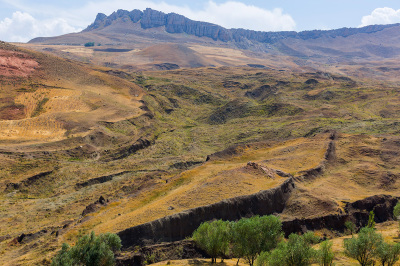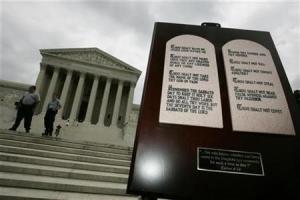Is the Great Flood fiction, folklore, figurative or fact?

Does it even matter if Christians regard Noah’s Flood as a myth, or as just a local flood? First consider that the credibility of the entire Bible is at stake when it comes to the Flood being a real, historical event or just a myth. The Flood account is woven throughout Scripture and is regarded as a real, worldwide catastrophic event by all the Bible authors, including six specifically who wrote about the flood: Moses, David, Luke (records the genealogy of Noah), the writer of Hebrews, Peter, and of course Jesus Himself. Without the flood, all six of these Bible authors are discredited.
How can Christians handle the allegations made by skeptics who argue that the Flood is just a myth, or was only a local flood? It’s actually quite easy. There are multiple lines of evidence for the flood that are covered in our movie, “The Ark and the Darkness: Uncovering the Mysteries of Noah’s Flood,” but let’s focus on just one: dinosaurs. Dinosaurs confirm Noah’s Flood in both a “small” and a “large” way. In a “small” way (microscopic, actually), the evidence of soft tissues still found in dinosaur bones represents “case closed” evidence for the flood, while at the same time closing the door for the idea of “millions of years of evolution.”
Let us explain.
The consensus opinion of the secular scientific literature regarding dinosaur fossils leading up until the turn of the 21st century was very straightforward: dinosaur fossils are just rocks. Dinosaur bones were thought to be hardened mineralized impressions of what used to be real bones. This view was widespread across museums, documentaries, and textbooks. It was the “common knowledge” of the paleontology field.
Then came 2005. Dinosaur researcher Dr. Mary Schweitzer discovered red blood cells and veins inside of a T-rex bone. The field exploded. Leading science journals erupted with articles like “Dinosaur Shocker” and “Schweitzer’s Dangerous Discovery.” Her discovery was deemed both a “shocker” and “dangerous” because finding of blood cells and soft tissues inside supposedly ancient dinosaur bones went against everything the paleontology field thought they knew for certain: the idea that dinosaurs lived and went extinct millions of years ago.
Since this breakthrough discovery published in 2005, the field has exploded with over 100 peer-reviewed scientific articles that have published 16 different types of soft tissue findings! This list includes blood vessels, blood cells, hemoglobin, bone cells, ovalbumin, chitin, raw bone material called hydroxyapatite, collagen, skin, histones, limited DNA, Phex, Keratin, Elastin, Cartilage, and most recently, even nerves!
Next there’s the “large” argument about dinosaurs dying in the Flood. If there was no worldwide flood, then how did a 13-state region (covering 600,000 square miles) get filled with dead dinosaurs mixed with marine life? The Morrison Formation is a 300-foot-thick mud “pancake” that covers about 1/5th (20%) of the Continental United States, and it’s filled with millions upon millions of dead dinosaurs mixed with ocean life. What is the most obvious explanation for this? Does a worldwide flood seem to explain this better than other explanations? We think so.
With such obvious evidence for a recent, worldwide flood, how can people — including Christians — just relegate the story to “myth” or hold the position that it was “just a local flood”? What are the implications for such beliefs? They’re significant, actually. Consider a Christian reading over Scripture, trying to let the truth and power of God’s Word sink into their hearts and souls. But then they run into passages written by the six Biblical writers — including Christ Himself — who obviously regard the flood as a real, worldwide event. Instead of their “faith roots” penetrating deeply into these passages, they are blocked by disbelief, thereby limiting the saturation and impact of God’s Word. To the Christian trusting the worldwide flood as a real historic event, there are no filters, no stoppages, no conditions or caveats. God’s Word sinks in and does its full work. The complete nature of the judgement of the flood, as well as the mercy He extended to only the eight people He saved — has serious implications for how we view God’s nature and His Word.
Relegating the flood to myth or just a local event sets up the Christian for mythologizing the rest of Scripture, and taking this mythical lens all the way back to the beginnings has Jesus being crucified on the cross for a mythical Adam who lived in a mythical garden. Atheists also understand the problem of a mythical Adam and Eve: “No Adam and Eve means no need for a savior. It also means that the Bible cannot be trusted as a source of unambiguous, literal truth. It is completely unreliable, because it all begins with a myth, and builds on that as a basis. No fall of man means no need for atonement and no need for a redeemer.”
Atheists understand the implications of Genesis. So must Christians. Too much is riding on this.
Daniel A. Biddle, Ph.D. is President of Genesis Apologetics, Inc. a 501(c)(3) organization dedicated to training youth pastors, parents, and students about Genesis, Creation, and the Flood. Daniel has authored/edited nine books and several articles on these topics, produced two films on Genesis and apologetics, including The Ark and The Darkness, returns to U.S. theaters for an encore showing on April 1, 2024.




























